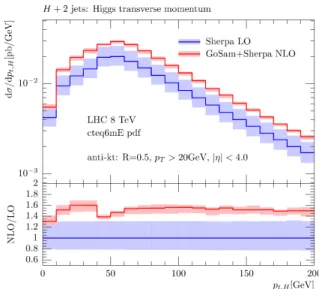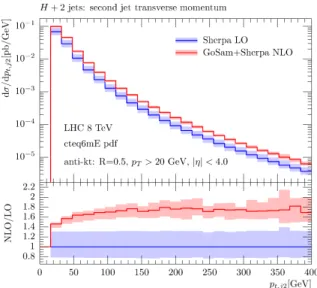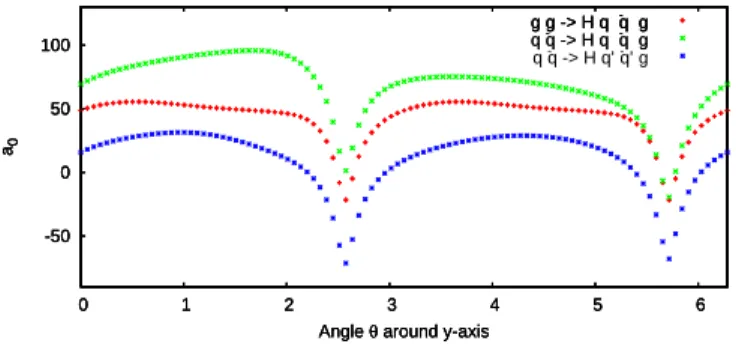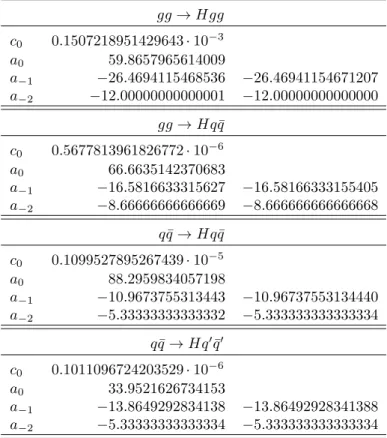arXiv:1301.0493v2 [hep-ph] 26 May 2013
NLO QCD corrections to the production of Higgs plus two jets at the LHC ✩
H. van Deurzen
a, N. Greiner
a, G. Luisoni
a, P. Mastrolia
a,b, E. Mirabella
a, G. Ossola
c,d, T. Peraro
a, J. F. von Soden-Fraunhofen
a, F. Tramontano
e,fa
Max-Planck-Institut f¨ ur Physik, F¨ ohringer Ring 6, 80805 M¨ unchen, Germany
b
Dipartimento di Fisica e Astronomia, Universit` a di Padova, and INFN Sezione di Padova, via Marzolo 8, 35131 Padova, Italy
c
New York City College of Technology, City University of New York, 300 Jay Street, Brooklyn NY 11201, USA
d
The Graduate School and University Center, City University of New York, 365 Fifth Avenue, New York, NY 10016, USA
e
Dipartimento di Scienze Fisiche, Universit` a degli studi di Napoli “Federico II”, I-80125 Napoli, Italy
f
INFN, Sezione di Napoli, I-80125 Napoli, Italy
Abstract
We present the calculation of the NLO QCD corrections to the associated production of a Higgs boson and two jets, in the infinite top-mass limit. We discuss the technical details of the computation and we show the numerical impact of the radiative corrections on several observables at the LHC. The results are obtained by using a fully automated framework for fixed order NLO QCD calculations based on the interplay of the packages GoSam and Sherpa. The evaluation of the virtual corrections constitutes an application of the d-dimensional integrand-level reduction to theories with higher dimensional operators. We also present first results for the one-loop matrix elements of the partonic processes with a quark-pair in the final state, which enter the hadronic production of a Higgs boson together with three jets in the infinite top-mass approximation.
Keywords: QCD, Jets, NLO Computations, LHC
1. Introduction
The recent discovery reported by ATLAS and CMS [1, 2]
indicates the existence of a new neutral boson with mass of about 125 GeV and spin different from one. At present, all measurements are consistent with the hypothesis that the new particle is the Standard Model Higgs boson. Never- theless, further studies concerning its CP properties, spin, and couplings are mandatory to confirm its nature.
The vector boson fusion (VBF) processes can be used to study the CP properties of the new particle, and to extract its couplings with the heavy gauge bosons. The dominant background to VBF comes from Higgs plus two jet produc- tion via gluon fusion (Hjj). The signal-over-background ratio can be improved by imposing stringent cuts on the Higgs decay products, and by requiring large rapidity sep- aration between the two forward jets. A veto on the jet activity in the central region further reduces the impact of the background. Indeed, VBF processes are character- ized by low hadronic activity, owing to the exchange of
✩
DSF-03-2013, MPP-2013-36
Email addresses: hdeurzen@mpp.mpg.de (H. van Deurzen), greiner@mpp.mpg.de (N. Greiner), luisonig@mpp.mpg.de (G.
Luisoni), pierpaolo.mastrolia@cern.ch (P. Mastrolia),
mirabell@mpp.mpg.de (E. Mirabella), GOssola@citytech.cuny.edu (G. Ossola), peraro@mpp.mpg.de (T. Peraro), jfsoden@mpp.mpg.de (J. F. von Soden-Fraunhofen), francesco.tramontano@cern.ch (F.
Tramontano)
a color-singlet in the t-channel. An accurate estimation of the efficiency of the central-jet veto requires the inclu- sion of the next-to-leading order (NLO) corrections to Hjj production [3, 4].
The leading order (LO) contribution to Hjj production has been computed in Refs. [5, 6]. The calculation was performed retaining the full top-mass dependence, and it showed the validity of the large top-mass approximation (m
t→ ∞ ) whenever the mass of the Higgs particle and the p
Tof the jets are not sensibly larger than the mass of the top quark. In the m
t→ ∞ limit, the Higgs coupling to two gluons, which at LO is mediated by a top-quark loop, becomes independent of m
t. Hence, it can be described by an effective operator obtained by integrating out the top quark degrees of freedom [7]. In this approximation, the number of loops of the virtual diagrams that need to be computed is reduced by one.
In the heavy top quark limit, the inclusive Higgs bo- son production cross section has been computed at NLO [8, 9] and at next-to-next-to-leading order (NNLO) [10–
12], showing a reduced sensitivity of the perturbative pre- diction to scale variations.
The implementation of final state cuts, to reduce the
impact of the Standard Model background for the identi-
fication of Higgs production demands fully exclusive cal-
culations of the theory predictions. In the m
t→ ∞ limit,
the NNLO corrections to Higgs production via gluon fu-
sion have been computed fully exclusively [13–16]. These
corrections also included the contributions of H + 1j final states to NLO [17–20], and of the H + 2j final states to LO [21, 22].
The impact of the NLO QCD corrections to the Hjj production rate has been studied in Ref. [3], using the real corrections presented in Refs. [23–25] and the semi- analytic virtual corrections computed in Refs. [26, 27]. A great effort has been devoted to the analytic computa- tion of the one-loop helicity amplitudes involving Higgs plus four partons, using on-shell and generalized unitarity methods [28–34]. The resulting compact expressions have been implemented in MCFM [4], which has been used to obtain matched NLO plus shower predictions within the Powheg box framework [35].
In this letter we present an independent computation of the NLO contributions to Higgs plus two jets production at the LHC in the large top-mass limit. These results have been obtained by using a fully automated framework for fixed order NLO QCD calculations, which interfaces via the Binoth Les Houches Accord (BLHA) [36] the GoSam package [37], for the generation and computation of the virtual amplitudes, with the Sherpa package [38], for the computation of the real amplitudes and the Monte Carlo integration over phase space. Details of the GoSam - Sherpa interface, together with a selection of ready-to-use process packages, can be found in [39, 40]. Moreover, the evaluation of the virtual corrections for a model described by an effective Lagrangian constitutes an application of the d-dimensional integrand reduction [41–46] to theories with higher dimensional operators [47]. In Section 2 we present the computational setup, whereas results on pp → Hjj at the LHC are discussed in Section 3.
Finally, we explore the possibility of extending our framework to consider the production of a Higgs boson plus three jets (Hjjj). We generate codes for the virtual corrections to the partonic processes with a quark-pair in the final state. We show the corresponding results in Sec- tion 4.
Appendix A contains the definitions of the Feynman rules for the direct interaction between the Higgs boson and gluons via effective couplings. In Appendix B, we show a property of the highest-rank terms of the one- loop integrands stemming from those effective rules. We close this communication by collecting, in Appendix C and Appendix D, the numerical results of the virtual ma- trix elements, evaluated in non-exceptional phase space points, for H + 2j and H + 3j final states, respectively.
2. Computational setup
We compute Higgs plus two jets production through gluon fusion in the large top-mass limit (m
t→ ∞ ). In this limit, the Higgs-gluon coupling is described by the effective local interaction [7]
L = − g
eff4 H tr (G
µνG
µν) . (1)
In the MS scheme, the coefficient g
effreads [8, 9]
g
eff= − α
s3πv
1 + 11 4π α
s+ O (α
3s) , (2) in terms of the Higgs vacuum expectation value v. The operator (1) leads to new Feynman rules involving the Higgs field and up to four gluons. They are collected in Appendix A.
Next-to-leading order corrections to cross sections re- quire the evaluation of virtual and real emission con- tributions. For the computation of the virtual correc- tions we use a code generated by the program package GoSam, which combines automated diagram generation and algebraic manipulation [48–51] with integrand-level reduction techniques [41–43, 52–54]. More specifically, the virtual corrections are evaluated using the d-dimensional integrand-level decomposition implemented in the samu- rai library [45], which allows for the combined determi- nation of both cut-constructible and rational terms at once. Moreover, the presence of effective couplings in the Lagrangian requires an extended version [47] of the integrand-level reduction, of which the present calcula- tion is a first application. After the reduction, all rele- vant scalar (master) integrals are computed by means of QCDLoop [55, 56], OneLoop [57], or Golem95C [58].
For the calculation of tree-level contributions we use Sherpa [38], which computes the LO and the real radia- tion matrix elements [59], regularizes the IR and collinear singularities using the Catani-Seymour dipole formal- ism [60], and carries out the phase space integrations as well.
The code that evaluates the virtual corrections is gen- erated by GoSam and linked to Sherpa via the Binoth- Les-Houches Accord (BLHA) [36] interface. This interface allows to generate the code in a fully automated way by a system of order and contract files containing the ampli- tudes requested by Sherpa. Furthermore, it allows for a direct communication between the two codes at running time, when Sherpa steers the integration by calling the external code which computes the virtual amplitude. A detailed description of this interface is beyond the scope of this paper and will be presented elsewhere [39].
For Hjj production, the partonic processes in the con- tract file are:
q q → H q q , q q ¯ → H q q , ¯ q q ¯ → H g g , q q ¯ → H q
′q ¯
′, q q
′→ H q q
′, q g → H g q ,
¯
q q → H q q , ¯ q q ¯
′→ H q
′q , ¯ g q → H g q , g g → H q q , ¯
g g → H g g . (3)
These processes are not independent, as they can be re-
lated by crossing and/or by relabeling. GoSam identifies
and generates the following minimal set of processes g g → H g g , g g → H q q , ¯
q q ¯ → H q q , ¯ q q ¯ → H q
′q ¯
′. (4) The other processes are obtained by performing the ap- propriate symmetry transformation.
The ultraviolet (UV), the infrared, and the collinear singularities are regularized using dimensional reduction (DRED). UV divergences have been renormalized in the MS scheme. In the case of LO [NLO] contributions we de- scribe the running of the strong coupling constant with one-loop [two-loop] accuracy, decoupling the top quark from the running.
The effective Hgg coupling, see Appendix A, leads to integrands that may exhibit numerators with rank r larger than the number n of the denominators, i.e. r ≤ n + 1. In general, for these cases, the parametrization of the residues at the multiple-cut has to be extended as discussed in Ref. [47]. As a consequence, the decomposition of any one-loop n-point amplitude in terms of master integrals (MIs) acquires new contributions, reading as,
M
one-loopn= A
n+ δ A
n. (5)
The term A
ncorresponds to the standard decomposition for the case of a renormalizable theory (r ≤ n), while the additional contribution δ A
nenters whenever r ≤ n + 1.
Their actual expressions can be found in Eqs. (2.16) and (6.11) of [47].
The extended integrand decomposition has been imple- mented in the samurai library. In particular, the coeffi- cients multiplying the MIs appearing in A
nand δ A
nare computed by using the discrete Fourier transform as de- scribed in Refs. [45, 53].
In the case of Higgs plus jets production, higher rank numerators arise from diagrams where the Higgs boson is attached to a pure gluonic loop. However, as shown in Appendix B, the rank-(n + 1) terms of an n-point inte- grand are proportional to the loop momentum squared, q
2, which simplifies against a denominator. Therefore, they generate (n − 1)-point integrands with rank r = n − 1. Con- sequently, the coefficients of the MIs in δ A
nhave to vanish identically, as explicitly verified. Since δ A
nin Eq. (5) does not play any role, the integrand reduction can be also per- formed with the current public version of samurai, which does not contain the extended decomposition - hence, im- plying a lighter reduction, with fewer coefficients involved.
We remark that, within the integrand reduction algo- rithm, it is possible to benefit immediately from the pres- ence of powers of q
2in the numerators, without any alge- braic cost: the contribution of those terms is automatically taken into account by the integrand reconstruction of the subdiagrams (because they give no contribution on the corresponding massless cut). On the contrary, within a tensor reduction algorithm, these terms would cancel only after the algebraic manipulation of the integrand.
The numerical values of the one-loop amplitudes of the processes (4) in a non-exceptional phase space point are collected in Appendix C. The values of the double and the single poles conform to the universal singular behavior of dimensionally regulated one-loop amplitudes [61–65]. Af- ter appropriate crossing to the H → 4-parton decay kine- matics, we compared our results with the ones presented in Table I of Ref. [26], finding excellent agreement. Fur- thermore, converting our results for the Hjj-production channels from DRED to the ’t Hooft-Veltman scheme, we are in perfect agreement with the most recent version of MCFM (v6.4).
Figure 1: Transverse momentum p
Tof the Higgs boson.
Figure 2: Pseudorapidity η of the Higgs boson.
Figure 3: Transverse momentum p
Tof the first jet.
Figure 4: Transverse momentum p
Tof the second jet.
3. Numerical results for pp → H jj
In this section we present a selection of phenomeno- logical results for proton-proton collisions at the LHC at
√ s = 8 TeV, as a sample of the results that can be easily obtained with the GoSam-Sherpa automated setup [37–
40]. A more complete analysis of Higgs production in gluon fusion, which merges several multiplicities [66] and employs the code for the virtual matrix elements of Hjj presented here, is going to be discussed in [67].
The results shown in this section are obtained using the parameters listed below:
M
H= 125 GeV , G
F= 1.16639 · 10
−5GeV
−2, α
LOs(M
Z) = 0.129783 , α
NLOs(M
Z) = 0.117981 , v
2= 1
√ 2G
F. (6)
Figure 5: Pseudorapidity η of the first jet.
Figure 6: Pseudorapidity η of the second jet.
We use the CTEQ6L1 and CTEQ6mE [68] parton dis- tribution functions (PDF) for the LO and NLO, respec- tively. The value of the strong coupling at the scale µ is taken from the PDF set starting from the initial values in Eq. (6). The jets are clustered by using the anti-k
Talgo- rithm provided by the FastJet package [69–71] with the following setup:
p
t,j≥ 20 GeV, | η
j| ≤ 4.0, R = 0.5 . (7) The Higgs boson is treated as a stable on-shell particle, without including any decay mode. To fix the factorization and the renormalization scale we define
H ˆ
t= q
M
H2+ p
2t,H+ X
j
p
t,j, (8)
where p
t,Hand p
t,jare the transverse momenta of the
Higgs boson and the jets. The nominal value for the two
scales is defined as
µ = µ
R= µ
F= ˆ H
t, (9)
whereas theoretical uncertainties are assessed by vary- ing simultaneously the factorization and renormalization scales in the range
1
2 H ˆ
t< µ < 2 ˆ H
t. (10) The error is estimated by taking the envelope of the re- sulting distributions at the different scales.
3.1. Results
Within our framework, we find the following total cross sections for the process pp → Hjj in gluon fusion:
σ
LO[pb] = 1.90
+0.58−0.41, σ
NLO[pb] = 2.90
+0.05−0.20,
where the error is obtained by varying the renormalization and factorization scales as given in Eq. (9). The LO distri- butions have been computed using 2.5 × 10
7phase space points, whereas all NLO distributions have been obtained using 4.0 × 10
6phase space points for the Born and the vir- tual corrections and 5.0 × 10
8points for the real radiation for each scale.
In Figs. 1 and 2, we present the distribution of the trans- verse momentum p
Tof the Higgs boson and its pseudora- pidity η, respectively. Both of them show a K-factor be- tween the LO and the NLO distribution of about 1.5 − 1.6, which is almost flat over a large fraction of kinematical range. Furthermore both plots show a decrease of the scale uncertainty of about 50%. Figures 3 and 4 display the transverse momentum of the first and second jet, whereas their pseudorapidities are shown in Figs. 5 and 6. The previous considerations are also true for these latter plots.
For the transverse momentum distributions, however, we observe a slight change of shapes. In the case of the lead- ing jet, increasing the p
T, the K-factor decreases from 1.6 to 1.4; while for the second leading jet, it increases from 1.4 to 1.6.
4. Virtual corrections to pp → H jjj
We explore the possibility of extending our framework to the production of a Higgs boson plus three jets at NLO.
The independent partonic processes contributing to Hjjj can be obtained by adding one extra gluon to the final state of the processes listed in Eq.(4). Accordingly, we generate the codes for the virtual corrections to the partonic processes with a quark-pair in the final state,
gg → Hq qg , ¯ q¯ q → Hq qg , ¯ q¯ q → Hq
′q ¯
′g . (11) The missing channel gg → Hggg, together with the phase space integration, will be discussed in a successive study.
-50 0 50 100
0 1 2 3 4 5 6
a0
Angle θ around y-axis
g g -> H q -q g
-50 0 50 100
0 1 2 3 4 5 6
a0
Angle θ around y-axis
g g -> H q -q g q -q -> H q -q g
-50 0 50 100
0 1 2 3 4 5 6
a0
Angle θ around y-axis
g g -> H q -q g q -q -> H q -q g q -q -> H q’ -q’ g




